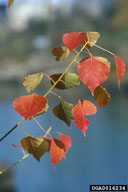
by Eddie Powell | Oct 7, 2014

Fall color of Chinese tallow. Image credit UGA Extension
Chinese tallow tree (Sapium sebiferum (L.) a deciduous and very aggressive tree. Many people appreciate the fact that it grows fast, provides great shade, and has a beautiful reddish fall color.
Despite it’s attributes, it is highly invasive and considered a noxious weed. It has spread to every coastal state from North Carolina to Texas, and inland to Arkansas. In Florida it occurs as far south as Tampa. Chinese tallow was listed in Florida as a noxious weed in 1998 which means that possession with the intent to sell, transport, or plant is illegal in the State of Florida.
The Chinese tallow tree can reach heights of 30 feet and the seeds resemble popcorn, hence its other name, popcorn tree. These popcorn shaped seeds and the aggressive root system sprouts make it very hard to control the spread of this tree. Animals also spread the seeds freely!
Although the Chinese tallow has great fall color problems come with it.
Some questions to ask yourself:
- Do you want great fall color and a yard full of Chinese tallow?
- Hey what about the neighbor. Do they want Chinese tallow in their yard?
Think about more than fall when planting.
To read more on how to control Chinese tallow follow this link: edis.ifas.ufl.edu/FR251
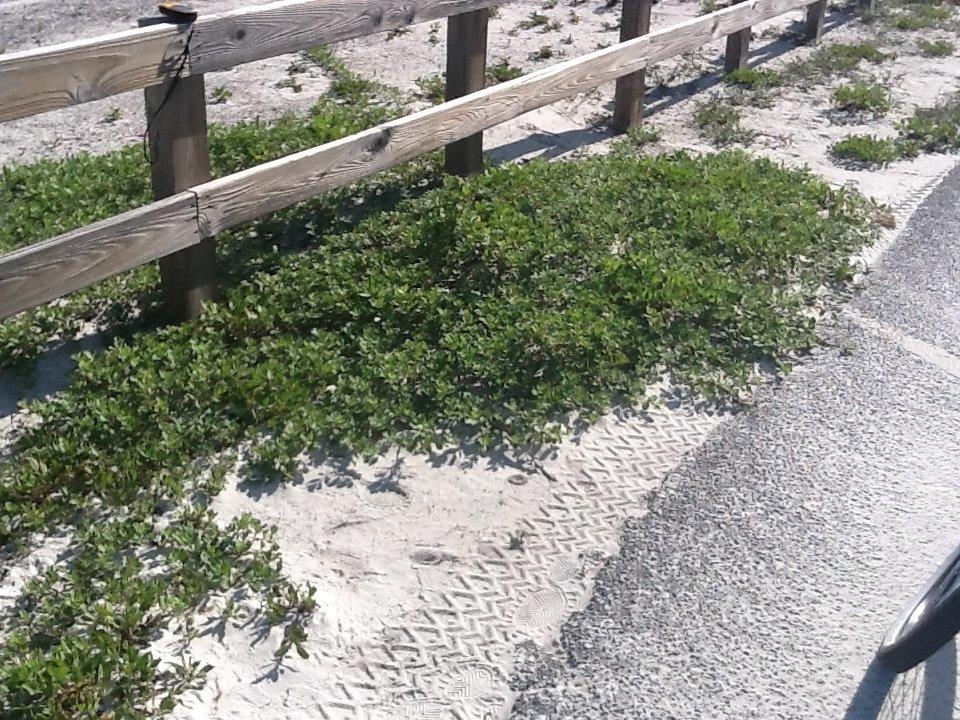
by Carrie Stevenson | Jul 21, 2014
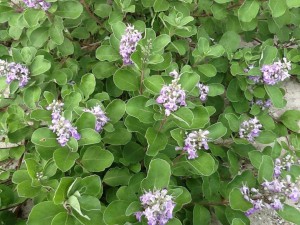
Many beachfront dwellers have intentionally planted beach vitex because of its attractive purple flowers. Photo credit: Rick O’Connor
Now that summer is in full swing, many of us are spending more time on our gorgeous Gulf beaches. Sea turtles are nesting and everyone gets excited at sightings of dolphins, sharks, and the Blue Angels. However, we have another recent visitor to our beaches, and this one isn’t spending money and renting condos. It has moved in from out-of-state and plans to stay, potentially wreaking havoc to our fragile beach dune ecosystems.
Florida is no stranger to invasive species. Reports and stories of pythons, popcorn trees, feral pigs, and others can be found everywhere. As a matter of fact, Florida and Hawaii have more problems with exotic plants and animals than any of the other states.
Beach Vitex (Vitex rotundifolia) is originally from the coastal areas of the western Pacific. It was brought to the United States by North Carolina State University in the 1980’s to restore dunes along coastal Carolina after severe storms. The plant is very salt and drought tolerant and performs well in direct sun and sandy soils; perfect for our coastal beaches. It grows about 3 feet tall and produces branches that extend along the surface of the sand over 60 feet from the tap-root. The flowers are lavender and found in the spring. By midsummer the flowers have dropped and pea-size dark fruit is produced. The fruit is also salt tolerant and can be carried by ocean currents as well as birds. The plant seemed a perfect choice for restoration projects.
And then…
And then it began to overgrow the primary dune system, choking the majority of the native plants including sea oats. The shrub size of the plant and the presence of vertical tap roots in lieu of fibrous ones did not suit it well as a dune forming plant; some studies found that it actually increased the erosion of some dune fields. Beach vitex releases allelopathic compounds, reducing the water content of the soil which stresses native plants thus reducing competition for space. And then there are the sea turtles. Evidence indicates that the growth of this plant over the primary dunes has made it difficult for female turtles to find nesting areas, while fast growing branches grow over incubating nests and make it difficult, if not impossible, for the hatchlings to emerge. The plant has become such a problem that it has been dubbed “Beach Kudzu” and there is a two-state task force to remove it.
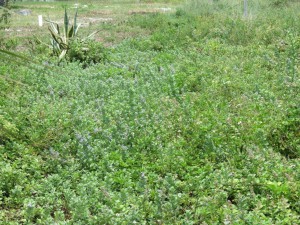
Beach vitex grows quickly and can rapidly take over an entire yard or beach dune. Photo credit: Rick O’Connor
Beach vitex has dispersed north to Virginia and south into Georgia. Currently it has been reported in only three Florida counties; Duval, Santa Rosa, and Escambia. Because of the few records in our state it is not currently listed as an invasive plant in Florida. The problem is, most biologists will tell you that the best way to eradicate an invasive species is to get it early. However most do not see the introduction of a new plant or animal as invasive until it becomes established and difficult to remove.
Natural Resource Agents with UF IFAS Extension are tracking the locations along the coast of the panhandle where this plant may exist. If you believe you may have it please let us know so that the location can be recorded. If you are interested in removing the plant we recommend cutting back to the tap-root. Dab the remaining tap-root with Round-Up. It is best if the remaining parts of the plant do not leave the property; if legal it is ok to burn. If you must transport it off the property we recommend it be dried on concrete and then double bagged before removing to the landfill. In many cases it may take several years to completely remove this plant. If you have any questions about this plant please call your local county Extension Office. Special thanks to Sea Grant Agent Rick O’Connor roc1@ufl.edu for use of this article.
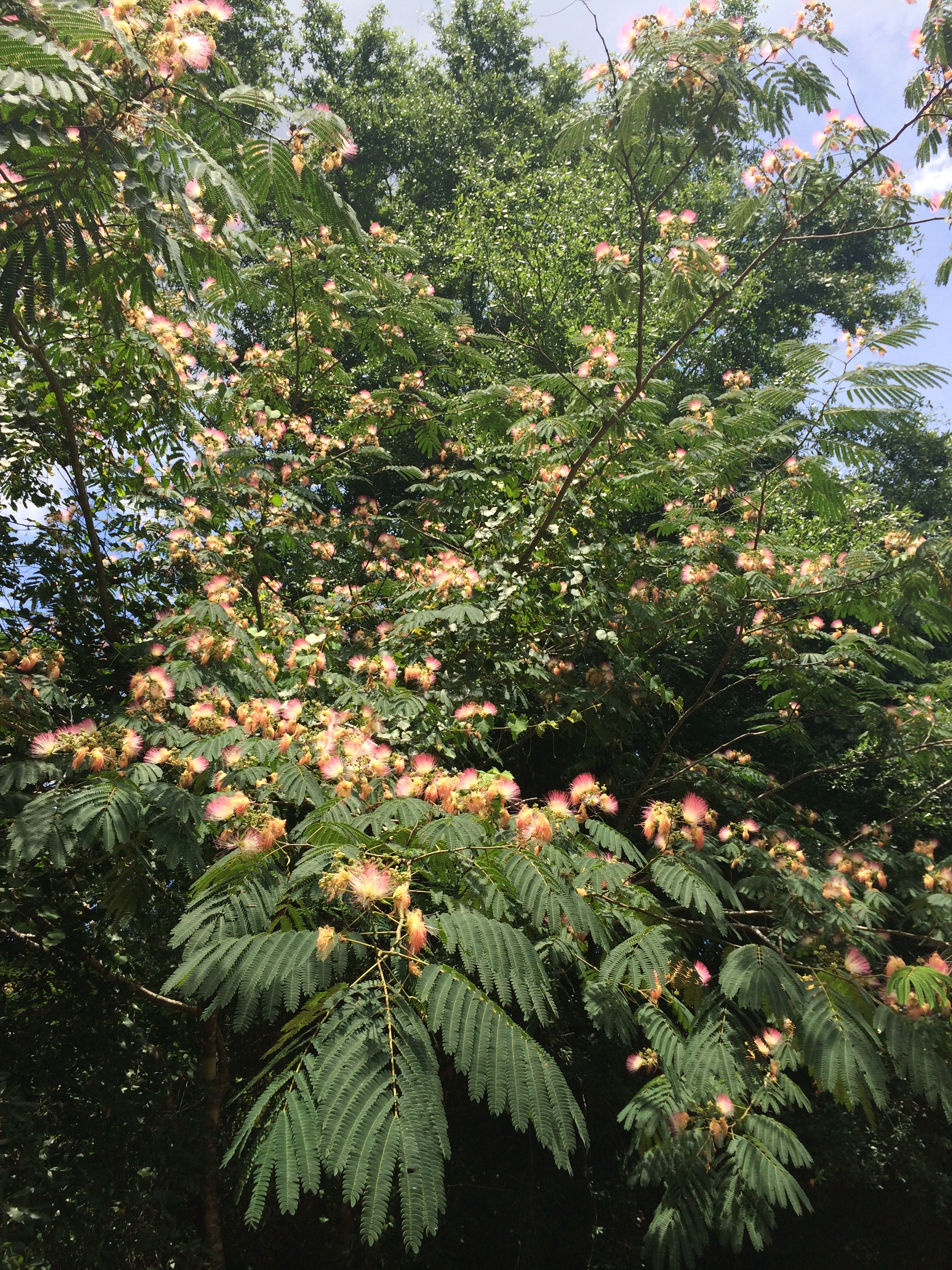
by Mary Salinas | Jun 10, 2014
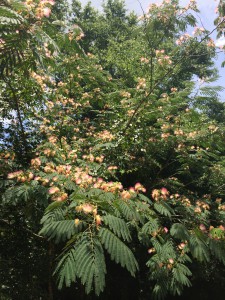
A mimosa tree invader in a natural area. Photo by Mary Derrick, UF IFAS.
All along the roadsides and in home landscapes this time of year, a profusion of fluffy pink blossoms are adorning trees known as Mimosa, or Albizia julibrissin. This native of China was introduced to home landscapes in this country in the 1700’s to enjoy the fragrant, showy flowers and fine, lacy foliage. However, there is a dark side to this lovely tree. After blooming, it produces an abundance of pods each containing 5 to 10 seeds. Seeds can be spread by wildlife and water; this is evidenced by the appearance of mimosa trees along the roadways, streams and in our natural areas. The seeds can also remain dormant for many years, allowing seedlings to keep sprouting up long after the mother tree is gone.
Mimosa has been categorized as an invasive exotic plant in Florida as it has not only naturalized, but is expanding on its own in Florida native plant communities. This expansion means that our native plants in natural areas get crowded out by the mimosa as it reproduces so prolifically.
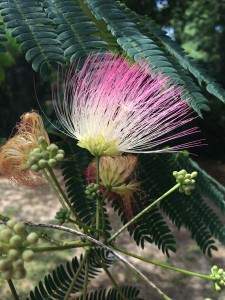
Bloom and foliage of the invasive mimosa tree. Photo by Mary Derrick, UF IFAS.
[important]The Florida Exotic Pest Plant Council (FLEPPC) publishes a list of non-native plants that have been determined to be invasive. Click here for the most recent 2013 list![/important]
The first step in controlling this pest plant is to remove existing plants in the landscape. Cutting it down at soil level and immediately painting the stump with a 25% solution of glyphosate or triclopyr should do the trick. Other details and control methods can be found here.
There are some native trees that make excellent alternatives to Mimosa such as fringe tree (Chionanthus virginicus), silverbell (Halesia carolina) and flowering dogwood (Cornus florida).
For more information:
Albizia julibrissin: Mimosa
UF IFAS Center for Aquatic and Invasive Plants: Mimosa
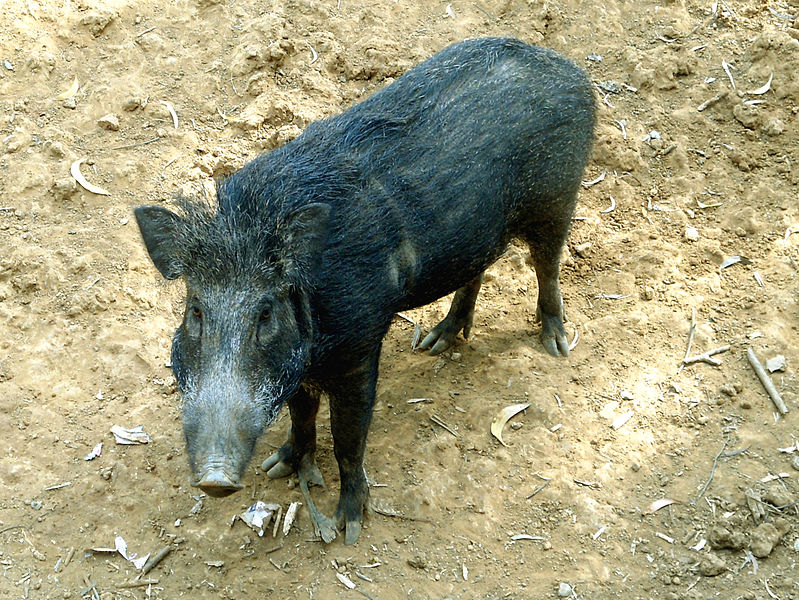
by Carrie Stevenson | Mar 18, 2014
The first week of March every year is designated “National Invasive Species Awareness Week,” an initiative to draw attention to the thousands of invasive plants and animals that move into our state and country every year. However, this is a problem that should draw focus year-round.
Invasive species are non-native or exotic plants and animals which can cause harm to the local economy, human health, and the environment. They often out-compete native species, causing habitat degradation, wildlife community imbalances, and diseases that can destroy economically important plants. This is a worldwide issue that can be addressed on local levels. In Florida, researchers have documented over 1,180 exotic plant species and more than 500 non-native fish.
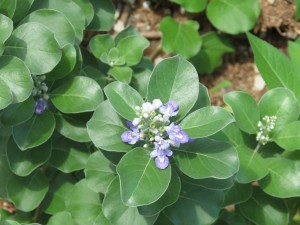
Beach vitex is a newly introduced invasive found on our local barrier island due systems. Photo credit: Rick O’Connor
Prevention is among the most effective ways to manage invasive species. Gardeners should be aware of invasive species and make sure they are not unintentionally passing them on to neighbors or natural areas. While many non-native plant species perform well in our yards and do not become invasive, pay close attention to new plants that start taking over your yard. If you’re unsure of the status of a plant, call your local Extension Office or check the Florida invasive plant list.
When enjoying outdoor activities such as camping, hiking, or biking, be sure to inspect what might have attached to your clothing to prevent further seed dispersion.

Wild hogs cause significant damage to ecosystems throughout Florida.
Released pets are a nearly impossible problem to manage, as well. If you have a pet that you can no longer keep, please find an alternative home for it. Releasing pets into the wild can have serious implications for native wildlife and cause harm to your animal. One needs look no further than the python problem in the Florida Everglades to see the extent of damage this unwise practice can cause. Great information on what to do with unwanted pets can be found at Habitattitude.
Among the most important invasive plants to be aware of in our area include: cogongrass, Chinese tallow (popcorn trees), coral ardisia, water hyacinth, Japanese climbing fern, Chinese privet, tropical soda apple, torpedo grass, and beach vitex. Among invasive animal species in the area, be on the lookout for: lionfish, crazy ants, feral hogs, and Cuban treefrogs.
There are many ways to get involved in the battle against invasive species, including joining your local Cooperative Invasive Species Management Area (CISMA) group. Special thanks to Brooke Saari (bsaari@ufl.edu) for contributing to this article.
by Les Harrison | Dec 2, 2013
Tarzan used them as a superhighway through the trees in every adventure created by Edgar Rice Burroughs. Villains and scoundrels alike fell prey to the ape-man and his horde of avenging simians descending on vines from the trees.
Great fiction, but removed from the reality of present day panhandle Florida. This is especially true about the vines which are impossible to use as a propulsion system and in many cases are exotic invaders.

Kudzu Vines Covering native vegetation – Image Credit Les Harrison UF IFAS
The most infamous is Kudzu (Pueraria montana), sometimes known as the weed that ate the south. It was introduced into the United States at the Philadelphia Centennial Exposition in 1876.
By 1900 kudzu was available by mail order as inexpensive livestock forage, and later sold by the USDA as an erosion control. The vigorous nature of the plant allowed it easily to escape into the wild.
It now exists in impenetrable tangles as large as 100 acres killing trees, covering structures, and smothering native plants. Kudzu is an aggressive leguminous vine capable of growing one foot per day. It can easily grow 60 feet in a single growing season.
It establishes roots sporadically as it covers an area, layering vines and foliage on top of each other. One key to this plant’s efficiency is its ability to orient each leaf so that the maximum amount of sunlight possible is absorbed. This multi-directional orientation of leaves also poses special problems with sufficiently wetting the top sides of foliage with herbicide.
Special effort is necessary to control kudzu. Older, well established plants are harder to control and completely eradicate. Follow-up spot treatments can require five to ten years in extreme cases. For easiest access, it is best to evaluate kudzu problems in winter when vines and foliage are withered.

Japanese Climbing Fern – Image Credit Les Harrison UF IFAS
Japanese Climbing Fern (Lygodium japonicum) is another aggressive exotic invasive, but not as commonly recognized as Kudzu. It is presently the only non-native invasive fern in the Florida.
Japanese climbing fern is a delicate looking perennial climbing vine. It is capable of forming a dense mat-like thatch capable of covering trees and shrubs. Initially, it was introduced from Japan as an ornamental.
This fern reproduces and spreads readily by wind-blown spores. Animals, equipment, and even people who move through an area with climbing ferns are very likely to pick up spores and move them to other locations.
It is scattered throughout the lower portions of Alabama, Georgia, Louisiana, South Carolina, and much of Florida, including panhandle. Planting or cultivation of this vine for ornamental purposes is prohibited by statute.
Both vines have many negative attributes. Among these are crowding out native vegetation, harboring destructive insects and diseases, and providing a fire bridge to the crown of unlucky trees.
Adequate control of both exotic vines has been achieved with multiple applications of herbicides. As with most invasive plants, repeated and correctly timed treatments are likely to be necessary.
Contact your local UF IFAS Extension office for more information












